There are golf trips in America -- think Hilton Head, Myrtle Beach, Scottsdale -- where the golf may be sublime or at least wildly plentiful, but once you're done hacking there's very little authentic local culture that is special enough to merit a cross-country trip. And then there is quite the opposite, a place where the golf is pleasant but not transcendent, yet everything off the course is so tantalizing that the thought of 36 holes a day seems, well, misguided.
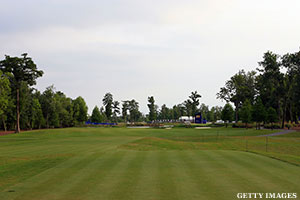
Exhibit A, your honor: New Orleans.
Exhibit B: The rest of Louisiana.
Now, before my Cajun golf friends de-Rolodex me, hear me out. Louisiana does have the Audubon Golf Trail, a collection of a dozen fine courses spread from the glorious Atchafalaya Basin, down south near the mouth of the Mississippi, to the lovely oaken hills near Shreveport up north. They are all enjoyable, and on the wetlands courses you might even lose a leg to the Alligator mississippiensis, but to say they are "world-class," as the state's tourism website boasts, is a stretch worthy of Nadia Comaneci. (PR people, if none of your state's courses is listed among Golf Digest's or Golfweek's top 100, you might hunt for another adjective.)
What Louisiana boosters should say is that its golf buffet is far more diverse and challenging than it was just a decade ago, and that it has such exceptional food, music, festivals and genuine America that it always qualifies as a great destination. Golf is just your excuse. So, with those caveats, I offer up a somewhat unorthodox golf trip that is more about jazz, zydeco and Acadiana than suburban fairways.
If you're flying in, almost certainly you'll be coming to New Orleans first, but my son and I wanted to drive in (from Austin, about seven hours west), so we could hit one of the Cajun music world's iconic monuments, in the town of Eunice, St. Landry Parish, in the heart of Acadiana. There, on highway 190 just east of town, every Saturday morning from nine to noon, you'll see cars parked bumper-to-bumper on the side of the road in that familiar random rural mashup that suggests a funeral or Jesus-in-the-tortilla sighting.
Get there early and you might see a high school prodigy with a fiddle on his shoulder greeting gray-haired men toting accordions as they walk into the parking lot of the renowned Savoy Music Center -- that would be savv-wah, of course -- where a Saturday jam session of traditional Cajun musicians qualifies as one of America's greatest free musical attractions.
"You boys from Austin?" asks Milton Vanicor, a remarkably unwrinkled, 93-year-old master of the fiddle and defacto leader of the jam. "That's where my quarterback is from. Drew Brees (of the New Orleans Saints). He can really hum it."
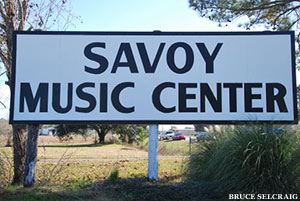
And so can "Mister Milton," a gentle giant of Cajun music who also sings a little as he takes the morning crew of a dozen locals through three hours of tunes such as "Convict Waltz" (check YouTube). There's a plinky upright piano by the window, one fellow on a triangle (more than one is really taboo though), some guitarists and several more fiddlers, male and female, young and old. Between songs you might hear a little Cajun French spoken between bites of boudin and cracklins -- crawfish and rice balls, with fried pig skins.
To Vanicor's right is lawyer Dave Johnson, squeezin' an Acadian button accordion made right there in the store by owner Marc Savoy, whose Savoy Family Cajun Band has toured the world. On Vanicor's left is a shy high school fiddler with braces wearing a red Ragin Cajuns T-shirt -- that's the University of Louisiana at Lafayette -- who is already so skilled that Vanicor happily defers to him on occasion.
"That boy is Zach Fusile," Vanicor tells me later, with obvious pride, 'and he is gonna be great. He's already great."
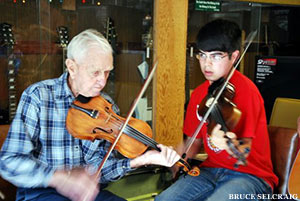
What makes this Saturday tradition special is not just the music. It is the unpretentious setting and honest simplicity that has been carefully protected by Savoy, a Cajun cultural preservationist whose wise rants against commercialism and homogenized pop culture are posted around the store. Neither does he suffer smart-ass journalists or musicians who blow-in for the "experience" and don't quite know their place. One understands that every last Neville Brother in Nawlins could walk through the front door and they'd still have to grab a seat in the third row and just paddle with the group. No divas allowed.
With a heaping thank-you to Austin-based Daily Yonder editors Bill Bishop and Julie Ardery, here is their splendid take on nearly everything worth doing in and around Eunice.
Now, finally, some golf.
Although Eunice does have a pine-covered, nine-holer at the Eunice Country Club, it's strangely over-priced, not particularly well-maintained and probably best suited for young kids just learning the game. The best sticks in town all take their game to the Coushatta Casino Resort, located 23 miles north of I-10 on US Hwy. 165 (Exit 44), five miles north of Kinder. There you have Koasati Pines, a long-if-you-wish (7,700 yards/slope 138) bayou country course designed by Rhode Island architect Kevin Tucker that is fun and reasonably priced ($50 weekdays, but stay-and-play deals at the casino are even better).
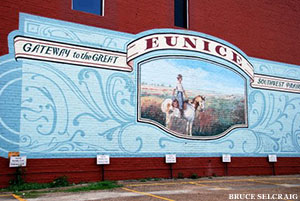
The course is a sprawling, wide-open layout, with lots of ponds, curvaceous TifDwarf Bermuda greens and fairly conventional bunkering. You can count on great conditioning nearly all year long on this decade-old course -- currently ranked No. 7 in Louisiana by Golf Digest -- but be aware of how recently it rained. Like many Louisiana courses, drainage is not the best after a steady soaking. Sadly, carts are mandatory, as are collared shirts, and you rowdy Levi's-wearing hooligans must leave your denim at home.
Now if you fall in love with the backroads of Louisiana, by all means research the Audubon Golf Trail and find the best courses around Lake Charles, Lafayette, Baton Rouge and Shreveport. Nothing says you have to go to New Orleans, but we certainly did ...
One of the joys of driving into this complex, still-recovering and always beguiling city is tuning your car radio to 90.7 FM and just waiting for one of country's best roots music stations to lock in. There is no better soundtrack to life in NOLA than WWOZ, a non-profit station with more than 70 volunteer hosts who obey no playlists or commercial demands. From their cramped French Quarter studios they serve up zydeco, Cajun, gospel, bluegrass, reggae, blues, ragtime, traditional country, funk, and every nuance of jazz from Charlie Parker to Coltrane to the legion of modern New Orleans talent, such as Terence Blanchard, Nicholas Payton, Marlon Jordan and Jonathan Batiste.
For some non-golf local knowledge, my son and I met WWOZ jock George Ingmire, host of "The New Orleans Music Show," at the Louisiana Pizza Kitchen, just down from the French Market. (It may seem touristy, but the pizza is hand-crafted and tasty.) With degrees in anthropology and fine arts from the University of New Orleans, Ingmire is the go-to guy on everything from new museums to insider bars.
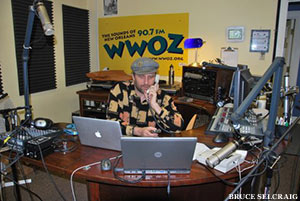
If you've dreamed of joining a "second line" -- that's the trailing group of mourners or celebrants at a New Orleans jazz funeral -- Ingmire says go to the WWOZ website and search for a 'social aid and pleasure club" announcement. They tend to be on Sundays around noon. Another WWOZ host does "The Movie Tour," a two-hour bus jaunt (with video screens) that takes you through the city to dozens of film locations, from "A Streetcar Named Desire," to "Easy Rider." A nice new trend in music venues is to use museums after hours for concerts. The Ogden Museum of Southern Art opens every Thursday from 6 p.m. to 8 p.m., featuring the usual eclectic music of the city; New Orleans Museum of Art, open Fridays until 9; and the Old U.S. Mint now has a third-floor jazz museum and performance space that often features great local bands.
For interesting excursions, Ingmire suggests the St. Claude Corridor (art galleries, music, hipness) or taking a free Canal Street ferry (from 6 a.m. to midnight, leaves every 30 minutes) across the Mississippi to historic Algiers Point on the West Bank, where you'll find interesting streets and pubs you'll crave, like The Old Point, a fine music spot billed as 'the most filmed bar in the South." Other NOLA bars Ingmire touts for music and purely local vibe: Vaughan's Lounge, 4229 Dauphine Street, like a throbbin' house party most nights; BJ's Lounge, 4301 Burgundy, a beloved Bywater dive; and The Candlelight Lounge, 925 N. Robertson, yet another magical spot where impromptu brass band jams make you wanna never leave.
Well worth several hours is the Rock 'N' Bowl, 3000 South Carrollton Avenue, a raucous venue for steaming zydeco, bowling and some awesome local dancers. (We were there during the Sugar Bowl and the Alabama football team had the place booked for hours.) Plus, the National World War II Museum, 945 Magazine St., an impressive new museum whose original films and exhibits go thoughtfully beyond mere flag-waving.
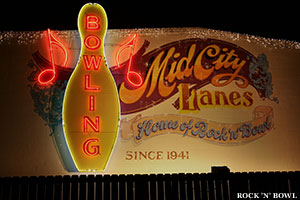
If you've never been to New Orleans and feel obligated to do Bourbon Street, by all means knock yourself out, but "I would never send anyone there," says Ingmire. "It's a tourist mall, T-shirt shops. Don't waste your time and money." As for safety, let's not sugar-coat this: The estimable Times-Picayune reports that NOLA is "America's unquestioned murder capital," with 199 murders last year, five times greater than comparable cities and a rise of 14 percent over 2011. A federal study shows most NOLA murders are drug-related, involve young black males who know each other and occur between 8 p.m. and midnight. "Don't go wandering unless you know where you are," Ingmire says. 'Good areas can turn bad very quickly. Be sure there's some foot traffic."
If you have survived all the revelry from last night, a lot of good golf awaits you. If you're the kind who wants someone to arrange all your rounds, Jeff Cohen at Big Easy Golf, 866-688-9938, is your guy. He'll candidly tell you about the quality of every NOLA course and can arrange personal or corporate tours in a number of locales, from Vegas to Canada.
The greeting at Lakewood Golf Club in Algiers now has a distinctive Scottish lilt. Glasgow-native Lawrence Hannigan, who for years charmed golfers at the Audubon Golf Club downtown (more later), welcomed me to my foggy 8:15 tee time with a quick answer to my first question: Where are all the trees?
What was once a dense oak-lined, traditional Southern course is now a wide-open rolling canvass. "We lost about 1,100 trees after Hurricane Katrina, Rita and Gustav," Hannigan told me. "We almost went bankrupt in 2003, closed down in 2005 and re-opened in 2009 after a $9 million renovation. It's like an entirely different golf course, but everyone seems to enjoy it, even the old timers." The course is now owned by the New Orleans Firefighters Pension Fund, and despite re-opening in the depths of the recession the new design and routing seem to have reinvigorated its loyal fans.
First opened in 1961 as the Lakewood Country Club and designed by architect Robert Bruce Harris, foremost adherent of the "Garden School" of architecture, Lakewood and The New Orleans Open became a favorite stop on the PGA Tour from 1963 to 1988. In that time, eight World Golf Hall of Famers such as Nicklaus, Watson, Casper, Ballesteros and Trevino played the tournament. Together they had 263 tour victories, including 53 majors.
But the tight, demanding course those giants played is just a memory. While the original design can still be seen on holes 12, 13 and 14, along with the indomitable cypress trees, whose mammoth root system makes them the most hurricane-resistant trees in this hemisphere, the rest of the course has been re-routed and reconfigured. It's walkable and very attuned to the average golfer's ability now.
Often the out-of-towner's first golf stop in NOLA will be the TPC of Louisiana, home to the Tour's Zurich Classic. Considered by many to be the best course in the city, this languid and very walkable Pete Dye course stretches out over 250 acres of wetlands across the Mississippi River delta, just 15 miles from downtown in Avondale. With the TPC brand you know the drill: excellent facilities, good food, nice practice areas and a steep price ($169 and higher for walk-ins, but as low as $70 if you find internet discounts.) In this year's Golf Digest ranking of Tour players' favorite courses among the 52 they play, this TPC ranked 45th, just slightly ahead of the TPC stops in San Antonio and Dallas (Byron Nelson).
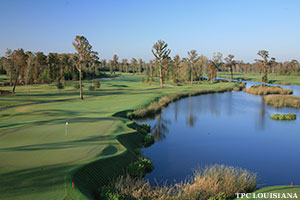
You can't read a review of TPC Louisiana (ninth hole at right), which is part of the Audubon Golf Trail, without knowing it has some 103 bunkers, including some maniacal pot bunkers that Dye put there just to make you whine. But if it's any consolation, I played here just weeks after it opened in 2004 and there were more, and enough had sadistic tendencies that Tour players began to complain. Hence, some refinements were made by Steve Elkington and Kelly Gibson. Yes, the TPC has been tamed somewhat so you will want to come back. The course lost plenty of outlying trees during Katrina and was closed for a year while they renovated six holes, but the park-like setting seems undisturbed. Moss-covered trees, still bayous and tip-toeing egrets give you just a hint of the natural beauty that defines the Louisiana coast.
One of the treats about New Orleans golf is the delightful Audubon Park course, a 4,220-yard, par-62 challenge right in the heart of the city, surrounded by one of the great urban parks in America. The food and attitude are unpretentious, family friendly, and despite the length this is very real golf, with Tif-Eagle greens and thoughtful conditioning year-round. Without massive par-fives, it becomes almost a challenging hybrid game to use more three-woods and fairway woods and to think about tight irons all day. One wonders why courses built on this model, even six- or nine-holers, couldn't work all over the country. Weekdays are $30.
English Turn Golf Club hosted the New Orleans tour stop for 17 years, and while it had its share of dramatic finishes, the 1988 Jack Nicklaus design never developed the affinity of Tour players like Harbour Town, Riviera, Colonial or Muirfield. It's hard to nail down any single factor that leaves some of us luke warm. There's water everywhere, rippling greens and tough par-fours, all neatly served up in a formulaic Nicklaus style. Perhaps the best critique is to compare a Nicklaus course side by side a Coore-Crenshaw course. The latter will inevitably have such a reverence for the natural world, the subtle strokes of nature, that from the first tee you feel a warmth and architectural coherence that last the whole day. Nicklaus provides more of a technical golf experience. But to each his own.
Those are the highlights closest to town, but if you want to drive 30 to 90 minutes from the Quarter, you should consider Ron Garl's Money Hill Golf Club in Abita Springs (reciprocal private play is allowed); The Island Golf Club, 14 miles south of Baton Rouge in Plaquemine, near the incomparable Atchafalaya Basin (1.4 million acres of swamp, cypress and gators); and a bit farther, The Wetlands Golf Club in Lafayette, where you must find the Blue Moon Saloon for great music.
WHERE TO STAY
If you're doing the Cajun culture tour through Acadiana, don't deprive yourself or the family of a stay at the remarkable LeVillage bed and breakfast just south of Eunice, about 16 miles north of I-10 on state highway 13. Picture a collection of beautifully renovated buildings on a six-acre country estate, not the "Gone With the Wind" high-plantation variety, but more modest, with huge trees, little dirt trails, kitty cats and frogs and huge shady porches that charm children and fancy wedding parties alike. My college kid wanted to stay longer.
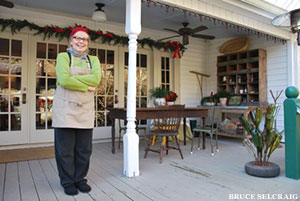
Owner Felicia Wiggins outdid herself serving us local fig preserves, Cajun cornbread, pumpkin bread, sweet dough pies and succulent homegrown tomatoes. "Say they're heirloom," Wiggins hollers from the kitchen, with a giggle.
Worldly yet completely at ease with her guests, she sat with us to watch the Saints on TV and let us store stuff in her frig. If you're not all stuffy, she lets on quick that she's just a bayou country girl at heart, albeit with a psychology degree and New York Review of Books habit. Cajun tunes from local KBON (101.1 FM) fill the homey dining room, which has a stunning Kawai piano in the corner. Guests from as far as Belgium and Australia have discovered her place, which features two separate houses, one of which sleeps ten and has a big-screen Sony with DirecTV. And what she doesn't know about local food and juke joints probably isn't worth knowing.
In New Orleans, there are so many little hideaways that you hesitate to mention just one, but we go for convenience in the Quarter and so have come to like LeRichelieu, 1234 Chartres St., a gracefully-aged boutique hotel with 86 rooms and suites that was built in 1845 and last renovated in 2006.
The staff was unfailingly helpful with directions, our room could have used a bigger TV, guests are very international and by far the hotel's single greatest attraction is a safe and free parking lot in one of the most congested neighborhoods in America. It's quiet for the Quarter, has a pool and rooms can be had for under $100. Still not sold? Paul McCartney stayed here for two months cutting an album.
-- Bruce Selcraig is a former writer with Sports Illustrated who lives in Austin.
Popular Stories On ThePostGame:
-- Train Smarter: The Truth About Swiss Balls
-- The Five Toughest Races In The World
-- Five Ways To Make Your Workout Less Boring
-- World's Tallest Basketball Player Dunks With Worst Vertical Ever








